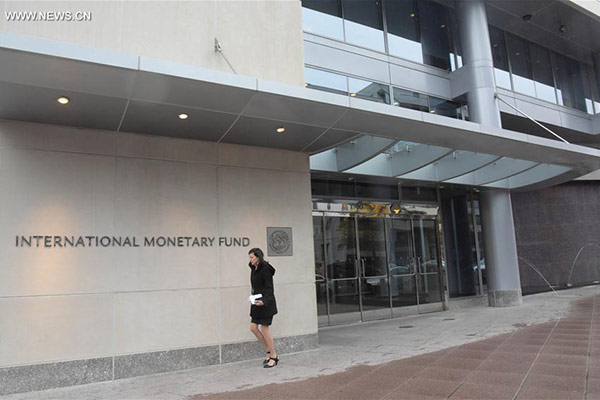 |
|
Photo taken on Nov 30, 2015 shows a woman walking past the headquarters of the International Monetary Fund (IMF) in Washington D.C., the United States. The International Monetary Fund (IMF) announced on Monday that Chinese currency renminbi (RMB) is eligible for joining the Special Drawing Rights (SDR) basket as an international reserve currency.[Photo/Xinhua] |
WASHINGTON - The International Monetary Fund (IMF) on Monday announced that the Chinese currency, renminbi, is eligible for joining its Special Drawing Rights (SDR) currency basket.
With the announcement, the Chinese currency, or the yuan, is to become one of the five reserve currencies fully endorsed by the 188-member multilateral organization.
The RMB "met all existing criteria," said the IMF board, which represents the fund's member countries, in a statement after a nearly two-hour meeting held Monday.
In accordance with the statement, the RMB will be included in the SDR basket as a fifth currency starting Oct 1, 2016 and will have a 10.92-percent weighting in the basket.
Since the 1990s, the SDR basket has consisted of four currencies -- the US dollar, the euro, the British pound and the Japanese yen.
IMF Managing Director Christine Lagarde said the RMB's inclusion into the SDR currency basket is "an important milestone in the integration of the Chinese economy into the global financial system."
A credit to China's reform agenda
The SDR is an international reserve asset created by the IMF in 1969 to supplement its member countries' official reserves. It can be exchanged among governments for freely usable currencies in times of need.
Nicholas Lardy, a senior researcher with the Washington-based Peterson Institute of International Economics, told Xinhua that the yuan's inclusion reflected IMF's acknowledgement of China's heft in the global economy.
"With China becoming the world's largest economy and the second largest trading nation, and the yuan is widely used across the globe, it is the right time to add yuan in the SDR basket," he said.
The IMF conducts the review of the SDR currency basket every five years. The selections of currencies are based on two criteria -- the size of the country's exports and whether its currency is freely useable.
At the last SDR review in 2010, the yuan met the export criterion, but failed to meet the "freely usable" standard.
To pave the way for the yuan's inclusion, the Chinese authorities have stepped up its pace of liberalizing the country's financial market to make the yuan freely usable across the globe.
In response to a string of operational shortcomings that the IMF evaluated this summer, the People's Bank of China, the country's central bank, announced an extensive reform measures package, including moves to further liberalize the exchange rate and interest rate regime, allow foreign investors to enter China's inter-bank market, and comply with IMF's more transparent statistical standard.
"China has taken enormous efforts to address those shortcomings and that dramatically increases the probability of yuan's inclusion," Lardy added.
Meg Lundsager, the former US executive director at the IMF, told Xinhua that what is important is it shows the evolution of the system is possible, reflecting what China has undertaken over the past years.
"China is clearly on the path of reform. It wants to show yuan is widely traded and freely usable by the IMF definition," said Lundsager, now a senior researcher with the Wilson Center, a Washington-based think tank.
